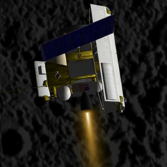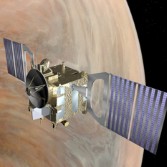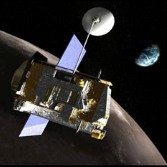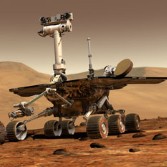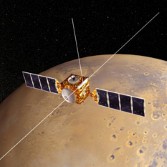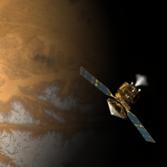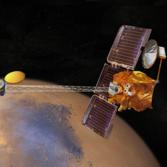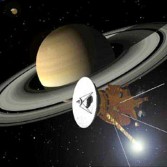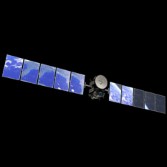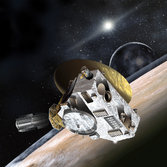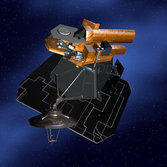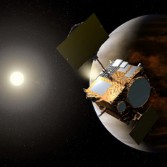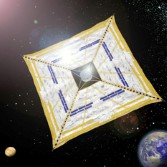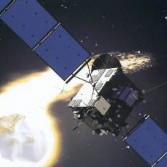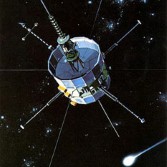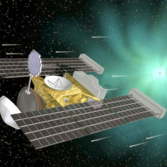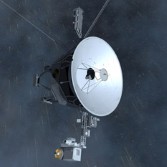Emily Lakdawalla • Feb 28, 2011
What's up in the solar system in March 2011
I don't think there's any question what the big event of this month will be: MESSENGER is finally, finally entering orbit at Mercury on March 18 at 00:45 UTC (March 17 at 16:45 for me). If everything goes well, of course. As of today MESSENGER has been in space for 2400 days since its launch more than six years ago, on August 3, 2004! This will be a truly nail-biting evening. If you're in the neighborhood of Laurel, Maryland, there's a public event at APL, which you should attend. The usual mission preview press briefing will be at 10:00 PST / 18:00 UTC on March 15.
The other big source of news for this month will be the Lunar and Planetary Science Conference, which takes place in Houston from March 7 to 11. Because it's been an especially difficult winter with my kids suffering numerous consecutive colds and ear infections, I've decided that I can't go this year, which makes me very sad. I hope that some conference attendees will volunteer to send me their notes and impressions, and I'll do what I can to cover it remotely.
One little notable event this month: New Horizons will finally cross Uranus' orbit (though the planet is nowhere nearby).
Before I go into mission-by-mission detail, here's Olaf Frohn's marvelous map of where all of our explorers are on March 1. Compare it to last month's diagram to see how things have moved.

Exploring the inner solar system:
It's finally here! This is the month that NASA's MESSENGER spacecraft will enter orbit at Mercury. Only 17 days remain until Mercury orbit insertion (which is planned for March 18, 2011). Events on orbit insertion day are summarized here, including a nice timeline, and there's an overview of the science plans here. I will, of course, be following these events very closely, in this space and on Twitter, and I'm booked for a 365 Days of Astronomy podcast on the mission on March 18, so look for that.
ESA's Venus Express remains in orbit on a mission that has been extended through 2014.
NASA's NASA's Lunar Reconnaissance Orbiter is busily mapping the Moon from its science orbit. The awesomest new image to hit their gallery is this gargantuan (24,000 pixels square!) wide-angle camera mosaic of the lunar nearside.
On to Mars:
Out at Mars, it's late spring in the southern hemisphere; we're entering the period of the longest sunlit days of the year, with the welcome boost to solar power that that brings. (It's currently Ls 245.6°.) Today it is Mars Exploration Rover Spirit sol 2544 and Opportunity sol 2523. Spirit has still not been heard from since sol 2210 (March 22), but they're still trying to raise her. Opportunity is still at Santa Maria crater, studying an exciting-looking rock called Ruiz Garcia, which is evidently interesting enough to delay the return to daylong drives. Six kilometers remain in Opportunity's journey to the nearest rim of Endeavour crater. Here is Eduardo Tesheiner's latest route map and Google Earth kml file for Opportunity.
ESA's Mars Express is back to routine Mars observations now that the latest set of Phobos encounters has ended. There were no Mars Webcam images last month, likely because of the poor communications situation near solar conjunction. Like Venus Express, Mars Express' mission has been extended through 2014.
NASA's Mars Reconnaissance Orbiter is keeping an eye on Mars' weather with MARCI; they report widespread dust activity across the whole planet just now, and "hazy" skies for the rovers. As always, check in on the latest captioned image releases from HiRISE for your dose of spectacular photos. I like this one which contains numerous skinny squiggly gullies.
NASA's Mars Odyssey is now the longest-lived spacecraft ever to operate at Mars. You can see the latest from its THEMIS instrument here; the website is misbehaving for me right now so I won't post a link to a specific image..
Exploring Saturn:
The NASA-ESA-ASI Cassini mission is on the outbound leg of Rev 145, and has most recently been performing some pretty mind-boggling detailed observations of Saturn's huge northern storm. It'll reach apoapsis, starting Rev 146, on March 6, at a distance very nearly as far from Saturn as Iapetus orbits; it'll reach periapsis again on March 20. There are no targeted flybys planned for March. Surprisingly, given the currently low-inclination orbit, there's only one relatively close brush with one of the moons in March, a 10,000-kilometer pass by Telesto; I don't know if any imaging will be attempted, since the Rev 145 Looking Ahead article says that all but two of the observations planned for Rev 146 cover Saturn and Titan.
Cruising from Here to There:
NASA's Dawn has now been in space for more than three years. It continues patiently propelling itself toward a rendezvous with Vesta in July 2011. Soon!
NASA's New Horizons has 12.84 AU to go to reach Pluto. It's still on course for a January to July 2015 encounter with the Pluto and Charon system. This month, around March 22, New Horizons will pass the mean orbital distance of Uranus (though the planet is nowhere nearby). It won't reach Neptune's orbital distance until August 2014, less than a year prior to its encounter with Pluto. There are 1596 days left until Pluto closest approach.
Deep Impact has completed its "EPOXI" mission extension, in which it studied extrasolar planets and encountered comet Hartley 2. NASA solicited proposals for another mission extension last October; there's no word yet on whether the spacecraft will get a second mission extension or not. Sadly, there's not enough fuel remaining to target a third comet, but it could conceivably be used for more exoplanet observations from its current orbit.
JAXA's Akatsuki is now in solar orbit, beginning its long cruise to a second encounter with Venus in December 2016. The Twitter feed indicates that Akatsuki is in regular radio contact with Earth, and is currently studying the effect of light pressure on its trajectory -- like IKAROS!
JAXA's IKAROS flew past Venus in December and has been operating successfully since May 21, 2010, really an amazing accomplishment for such a small, experimental craft. According to the latest entry in the IKAROS blog, they most recently communicated with the spacecraft yesterday.
ESA's Rosetta mission has completed a major set of rocket firings to set itself up for the last leg of its cruise to its target comet. After going through solar conjunction in May and June, it will hibernate from July 2011 to January 2014. The next object it'll encounter will be its goal, comet 67/P Churyumov-Gerasimenko; rendezvous is set for May 2014.
The International Cometary Explorer remains on course for a return visit to Earth in 2014. When it does, ICE can be returned to a Sun-Earth L1 halo orbit, or can use multiple Earth swingbys to encounter Comet Wirtanen during its near-Earth apparition in December 2018.
Now that the Tempel 1 encounter is complete, this may be the last appearance of NASA's Stardust mission in these roundups. Stardust has finished its departure photography and calibration, and the next event for the spacecraft will be its decommissioning.
Finally, NASA's Voyager 1 and 2 spacecraft are still going strong. Follow the current position of both using the Twitter feed of Voyager 2, which also mentions the position of Voyager 1 once a day.
The Time is Now.
As a Planetary Defender, you’re part of our mission to decrease the risk of Earth being hit by an asteroid or comet.
Donate Today

 Explore Worlds
Explore Worlds Find Life
Find Life Defend Earth
Defend Earth


